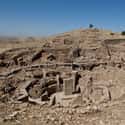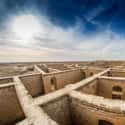-
(#9) Ancient Greece
Ancient Greece was a collection of city-states that shared a single culture. Often considered the birthplace of Western civilization, Ancient Greece created the foundations for Western philosophy, literature, mathematics, history, drama, art, and government.
During the 4th and 5th centuries, the Greeks developed a form of artistic realism that allowed artists to sculpt harmonious, realistic, and beautiful renditions of the human figure out of marble and bronze. Artist Polykleitos of Argos formulated a system of proportions that was particularly influential at the time. Such realism was almost completely unseen in the rest of the ancient world, and the knowledge was lost for almost a millennium until it was rediscovered during the Renaissance.
In the 5th century, philosopher and mathematician Pythagoras formulated a mathematical theorem that would always be able to calculate the lengths of any right triangle (a^2+b^2=c^2). Taught today in high school geometry classes, the Pythagorean Theorem established the foundation for more complex engineering, navigation, and astronomy.
In the same century, Democritus theorized that all matter is made of small, indivisible structures called atoms. Despite being unable to see or go beyond the theoretical, his theory was largely proven to be true 1,400 years later and became the basis of modern atomic theory.
The Ancient Greeks built colossal monuments, some of which still stand to this day. In Athens, there was the Acropolis, a 7-acre compound that rises 490 feet above the rest of the city and housed its religious temples. The Mausoleum at Halicarnassus was a 104-foot by 85-foot marble funeral monument adorned with 6-foot high marble statues. The Colossus of Rhodes was a 108-foot statue of the sun god Helios who stood above the city's harbor.
Of the Seven Wonders of the Ancient World, five of them had Ancient Greek origins.
-
(#3) The Rapanui
Some 2,300 miles off the coast of Chile is a small island called Rapa Nui, also referred to as Easter Island, originally settled by migrating Polynesians between 300 and 400 CE. They developed a rich culture, evident by the 900 or so enormous stone figures scattered around the 63-square-mile island.
Often mounted atop stone platforms called ahus, these stone statues, or moai, were chiseled from tuff, a porous volcanic rock. Though they were obviously used for a ceremonial purpose, historians and archaeologists have no idea what specific role they played, why the Rapanui made such a large quantity, or how they managed to move them. Each moai is about 32 feet tall and weighs about 82 tons.
Historians suggest the Rapanui cut down palm trees and used those logs to transport the stone heads. Regardless of whether or not that was the method, making and transporting the moai would have taken great amounts of manpower.
Based on how barren the island is now and the erosion that has taken place, it's theorized that the Rapanui left a huge ecological effect on the island, which may have caused the entire civilization to collapse. By wiping out most of the island's palm trees and replacing them with agricultural land, most of the nutrient-rich soil eroded. Without that soil, the crops dwindled, and in the ensuing years the island's population struggled through intermittent periods of conflict and peace.
-
(#7) Ancient Turks
In Southeastern Turkey resides what may be the oldest human-made temple in history, Gobekli Tepe. Dated to around 9000 BCE, prehistoric people gathered around 300 seven-to-10-ton stones at the highest peak of a mountain ridge that rises 1,000 feet above the surrounding valley. There, the ancient builders arranged what archaeologists believe was a religious temple.
The structure itself is built from four arrangements of monolithic pillars, each encircled by smaller stones. Many of the stones are elaborately decorated with carved foxes, scorpions, lions, and other animals, along with more abstract designs. The most prominent, however, are carvings of vultures, which archaeologists believe to be representations of death.
Gobekli Tepe is still shrouded in mystery. Only 5% of the site has been excavated, but what has been found predates metal tools, pottery, the wheel, and agriculture. Archaeologists believe it was created by a hunter-gatherer society, but the organization and the tools needed to build Gobekli Tepe do not align with contemporary theories about how early hunter-gatherer societies functioned.
In the surrounding area, evidence suggests humans were beginning to domesticate sheep, pigs, and cattle 1,000 years after Gobekli Tepe was erected, thus putting them at the forefront of the agricultural revolution. But there is also no evidence of permanent housing, which has led historians to believe it could have been a pilgrimage site rather than a permanently settled temple.
-
(#4) Sumer
Sumer is considered the "cradle of civilization" due to it being one of the earliest cultures to appear on the historical scene. It is unclear when the first Sumerians migrated between the Euphrates and Tigris rivers, but by 3600 BCE, they'd created the world's first cities, including Ur, Eridu, and Uruk.
The development from primarily small settlements to cities was a slow, thousand-year-long process, and the Sumerians depicted this transformation in a cuneiform document from 2100 BCE called the "Sumerian King List." It is described as a period in which the gods and Sumer's kings were able to triumph over chaos. During this time, the society created systems and inventions to harness or counteract the harsh conditions of what is now modern Iraq, including irrigation, the wheel, and sailboats.
Despite adapting technology to allow society to grow larger than ever before, Sumer's greatest achievements occurred around 2000-1750 BCE, in a period that was later named the Sumerian Renaissance. During this period, the Sumerians created basic standards that are taken for granted today, including the concept of time.
The Sumerians had a duodecimal and sexagesimal counting system (meaning they had a 12-based and 60-based counting system, rather than the decimal 10-based system used today) and divided the days by the same system.
The Sumerians also created the world's first legal code, named after the Babylonian king who created it, Hammurabi. Hammurabi's Code provided the basis for city and legal administration by defining rules that every citizen must abide by.
-
(#6) The Celts (Or Their Neolithic Predecessors)
Originating from central Europe around 1200 BCE, the Celtic people spread across Western Europe and established themselves as a dominant cultural group in the region. However, they did not remain a monolithic people. Modern-day France, Ireland, and Britain were once populated by different Celtic groups, such as the Britons, Caledonians, and Galatians.
Though they made up a large part of Western Europe, and eventually the Roman Empire, the Ancient Romans commonly wrote these people off as "barbarians" who were "unfamiliar with the use of clothing," as an ancient commenter wrote.
The 17th-century archaeologist John Aubrey theorized that, despite being highly criticized by the Romans, Celt Druids were able to build an incredible structure on the southern end of Britain, Stonehenge. The circular earthwork has a total diameter of 360 feet, and is made up of about 50 sarsen stones that are about 13.5 feet tall, 7 feet wide, and weigh about 25 tons each.
Aubrey's claim has been challenged by others who say the giant structure predates the Celts by 1,000 years and may have been built by multiple Neolithic tribes who contributed to different steps of the construction process.
Whether built by the Celts or their Neolithic predecessors, their construction method remains a mystery, as does the purpose behind Stonehenge. There are several historical theories for both, including:
- Builders used logs to roll the stones.
- They used levers and weights to lift them.
- It was built for ceremonial purposes.
- It was built for time-keeping purposes.
-
(#2) The Mayans
The Mayans were (and still are) the indigenous people of Mesoamerica, and their society was complex politically, culturally, and scientifically. Established millennia before European contact, around 2000 BCE , the Mayans were not a singular entity but a cultural group that can be divided into different eras.
Various hegemonic political powers and independent city-states rose and fell throughout the culture's history, during which Mayans developed certain systems and technologies far more advanced than those in the Old World.
Very early in their history, the Mayans began their own hieroglyphic writing system, complex mathematics, and a calendar system far more accurate and detailed than anything else around the world. By watching the stars, the Mayans devised three calendars that worked in tandem: the Haab (a 365-day civil calendar divided into 18 months), the Tzolkin (a sacred calendar with 260 days divided into 3 periods), and the Long Count Calendar (a calendar used for lengthier calculations of time.)
Around 1000 BCE, the Mayans began building pyramids. These monumental buildings towered over the Central American rainforests, and their architecture was designed with their astronomy and time-keeping in mind. One of the most well-known Mayan pyramids, Chichen Itza, has steps running from its base to the top on each of the pyramid's four sides. Each set has 91 steps, which total 364 - or 365, if you consider the final step into the pyramid.
Despite the society's complexity, the entire civilization collapsed between the 8th and 9th century CE, leaving many of their expansive cities completely abandoned. Historians, archaeologists, and laymen have proposed many theories for their sudden disappearance, including deforestation, drought, and foreign incursion, but none have been determined for certain.
New Random Displays Display All By Ranking
About This Tool
There are many ancient cultural sites on the earth that have always been the focus of research by scientists and archaeologists because these ancient buildings are the witnesses of human civilization, but some great civilizations have appeared buildings that are too big, too heavy, or too complex, they suspected of being built by aliens. Do you believe in the existence of aliens?
Some people think that the ancient builders of the Egyptian pyramids and the Nazca Line followed the instructions of the aliens. Perhaps the people who built these great buildings did not belong to the earth. The random tool lists 12 ancient civilizations that may be contacted by aliens.
Our data comes from Ranker, If you want to participate in the ranking of items displayed on this page, please click here.
















